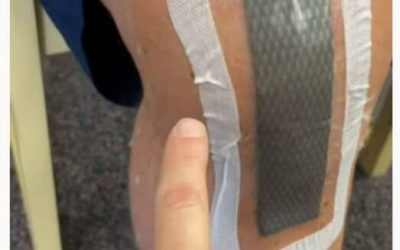How To Use A Stationary Bike After A Total Knee Replacement
An exercise bike is an excellent option after knee replacement surgery.
The adjustable seat and variable resistance can make it the perfect tool for increasing range of motion, improving endurance, and getting you back to the active lifestyle you enjoy.
Lightly used exercise bikes can be purchased on eBay and Facebook marketplace as well as second-hand retailers like Play It Again Sports.
New bikes may be purchased on Amazon or other sports retailers.
If possible, it is recommended that you purchase your bike before surgery in order to get a feel for riding it.
Top 4 Best Type of Exercise Bike To Rehab Knee
1.) Recumbent Bike
Recumbent bikes are the most popular bikes used in rehab for post-surgical care following a total knee replacement.
These bikes are most easily identifiable by the large seat and backrest.
If you would like more information about recumbent bikes and how to pick the best one for total knee replacement rehab check out this article.
2.) Upright Stationary Bike
An upright stationary bike has a seat positioned higher than the pedals and usually more over the pedals than a recumbent bike.
3.) Airdyne Bike
Although Airdyne is a model and not a type of bike, it deserves its own category.
The Schwinn Airdyne has been a classic bike for decades. Made of mostly all steel, this workhorse in the gym almost never breaks down and has helped countless individuals build strength and endurance but leveraging the power of the wind.

4.) Spinning Bike
A spinning bike has been popularized by spinning classes. This stationary bike is similar to a classic road bike. It has a small seat and positions the rider in more of a forward-leaning position. This bike is great for speed and endurance and is preferred by endurance athletes over recreational cyclists.
What Is A Recumbent Exercise Bike?
A recumbent bike is a type of stationary bike that has a larger seat with a full-length backrest.
It is often recommended for individuals with low back pain attributed to spinal stenosis.
It is differentiated from an upright, stationary bike because the pedals are positioned in front of the pelvis and the body is in a more reclined position.
Can I Do Too Much Exercise After Knee Replacement?
Absolutely YES!
Your body is no different than an Olympic athlete’s body. You need rest and recovery as much as you need exercise.
After a total knee replacement, your body has experienced a tremendous amount of trauma.
The pain levels are high which increases your stress hormones.
You aren’t sleeping very well which slows down your tissue healing.
And the emotional stress levels are usually through the roof so all of this makes for a challenging time for your body to recover.
During the first two weeks, you should get plenty of sleep, great nutrition, and focus on healing/recovery.
During the next three to six weeks your stamina will improve and your ability to move will skyrocket.
Finally, after 6 weeks the surgical incision will be healed and you will be ready to really start to increase the frequency and intensity of exercise.
Is A Bike Good For Limited Knee Flexion?
Yes! A bike is great for limited knee flexion if you want to improve your knee flexion.
An upright stationary bike is usually preferred over a recumbent bike because it required less knee flexion initially.
As your range of motion improves you may choose to move your seat closer to the pedals to continue to increase knee flexion.
How Much Knee Flexion Will I Need During Cycling?
This depends on the kind of bike you choose. A general rule of thumb is about 90 degrees of flexion to complete a full revolution. If you move the seat closer to the pedals you will need more.
If you cheat a bit and move your seat further away from the pedals you may complete a revolution with less knee flexion.
Next, as your range of motion improves you would move the seat closer to a more normalized position.
How Much Pain Can I Expect After A Total Knee Replacement (TKR)?
A total knee replacement is often considered more painful than a total hip replacement.
The first 24-48 hours after the procedure your anesthesia from the surgery will help manage the initial pain response.
Follow your surgeon’s guidance for dosing your medication, but many clients will say after the first 48 hours the pain may intensify but should always be manageable.
The pain should never reach the point of agony. A pain level of 7 out of 10 on the Mankoski Pain Scale is described as “Makes it difficult to concentrate, interferes with sleep. You can still function with effort. Stronger painkillers are only partially effective.”
If your pain levels reach a 7 it is recommended you contact your surgical team.
Can I Have A Knee Replacement Without Doing Physical Therapy?
Yes! The trend has been toward less physical therapy for individuals who do not have complications following a total knee replacement.
As a physical therapist myself, I would rather a client receive a couple of physical therapy sessions before surgery to better prepare for what is to come, than do less follow-up therapy as long you are progressing normally.
Is An Exercise Bike Good For Knees?
Yes, an exercise bike can be great for your knees. But so can lots of other exercise equipment.
The best piece of exercise equipment is the one you know you will enjoy.
I have worked with clients who use a treadmill every day and others who use a treadmill to hang clothes.
Is An Airdyne Bike Good For Knee Rehab?
One of my favorite exercise bikes is the Schwinn Airdyne. The ability to use the arms and legs in combination or just the arms or just the legs is a huge benefit.
The steel body of the bike also makes it last for a long time without the risk of breakdown.
I have seen these bikes resell on Craigslist and eBay for top dollar simply because they age so well.
Can I Use A Treadmill After Knee Replacement Surgery?
Yes, a treadmill can be a wonderful addition to a total knee replacement recovery program.
The treadmill offers a clean, flat, well-lighted surface to walk on.
Since you are probably a human being reading this post, you likely move through space on two feet. A treadmill is one of the most functional pieces of training equipment that allow you to weight-bear and walk the way you would in the community.

Anthony Maritato, PT
Physical Therapist
Anthony Maritato, PT has been a licensed physical therapist and private practice owner since 2006. Ohio license #PT011602.
Anthony has been passionate about helping patients recover from total knee replacement surgery as well as rotator cuff repair surgery.
More Blog Posts …
Who Orders the Antibiotics After Knee Replacement Before Dental Work
Are Antibiotics Required Before Dental Work After Total Knee Replacement The topic of prophylactically using antibiotics after knee replacement before dental work remains controversial. Link This 2016 publication in Arthroplasty Today, suggests "Current international...
Second Knee Replacement 5 Quick FAQs
Is a second knee replacement worse than the first? There is a huge difference between the second knee replacement on the same knee, also known as a total knee revision surgery, and the second knee replacement on the other knee. As a physical therapist, I am fortunate...
3 Months After Total Knee Replacement
What to expect 3 months after total knee replacement During the first 3 months after total knee replacement, you may experience lots of changes and rapid improvement. Range of motion will go from practically nothing to 120 degrees of flexion and 0 degrees of...
How to Choose the Best Recliner for Knee Replacement
Is a recliner required after total knee replacement surgery? Absolutely not! A recliner might be a convenient luxury, but if you don't already own one I would not tell you to rush out and buy one. In this article, I will discuss how to achieve the same positions on a...
Best Ankle Pumps Exercise [Video] 3 Tips After Total Knee Replacement Surgery
What are ankle pumps? Ankle pumps are a simple and effective exercise for post-surgery recovery and sedentary lifestyles after knee replacement surgery. Ankle pumps, as the name suggests, are simple exercises involving the rhythmic flexing and extending of the ankle,...
Why Does A Knee Pop When Standing From A Chair: Total Knee Replacement Questions
Facebook Question About A Knee Pop Sensation "I am 2 yrs post op on my right knee and when I get up from a sitting position it makes a pop sound almost all of the time. Is that normal." My response: Watch the video below to localize where the knee popping is coming...
How to Shower After Knee Surgery 2022
When and How to Shower After Knee Surgery: Post Surgical Instructions Timeline Consult your surgeon or surgical team before showering. They will provide recommendations specifically for your post-surgical situation. Dr. Paul G. Kiritsis, M.D. suggests his patients are...
Best Used Exercise Equipment After Total Knee Replacement Surgery
Buying used exercise equipment after a total knee replacement can be a great way to save money while rehabilitating your new knee. In this article, I will share my 5 favorite places to find used exercise equipment. Facebook Marketplace eBay Craigslist Play It Again...
Tips For Traveling By Car After Knee Replacement Surgery
When is it safe to traveling by car after knee replacement surgery as a passenger? Most patients return to driving after total knee replacement surgery in 6 weeks. Here in the United States some patients will return to driving sooner if the replacement was on the left...
Pickleball Weight Loss Strategies
How Many Calories Are Burned Playing Pickleball for 60-minutes? Pickleball is a great cardiovascular workout if the intensity is kept high. A play may burn 8-11 calories per minute on the low end going up as high as 15-calories per minute on the higher end. Pickleball...




![Best Ankle Pumps Exercise [Video] 3 Tips After Total Knee Replacement Surgery](https://totaltherapysolutions.com/wp-content/uploads/2022/08/ankle-pumps-after-total-knee-replacement-surgery-2.jpg)




